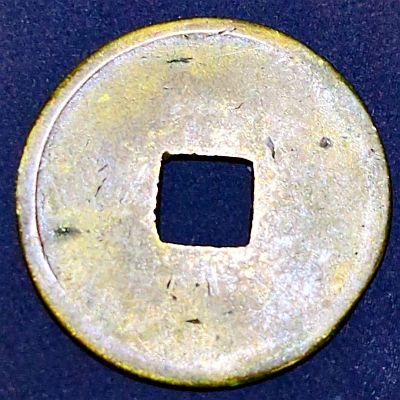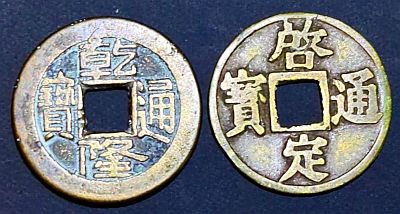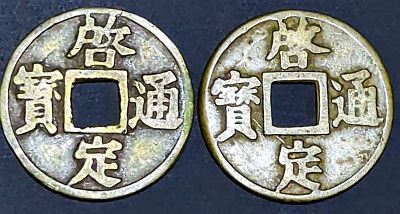Most Asian cash coins, such as the Japanese 4 Mon and the Chinese Cash coins were cast, with molten metal poured into a mold, shaping it into coins. Japan was just about the first Asian country to embrace western machine milling methods with the Mieji restoration in the 1870s.
Vietnam was interesting in that it used both cast and machine struck coins through the early 20th century.

The Khải Định Thông Bảo 1 Cash coin was issued from 1916-1926. Immediately recognisable as a “cash” coin, the thin rim compared to Chinese cash coins means the characters can be larger, with more empty space (or “Fields” between.

The reverse is completely plain. There is no inner rim around the square hole on the reverse, and only hints of a rim around the edge.

Here is the Vietnamese milled coin next to a cast Chinese Qian Long Tong Bao.

Looking at the same two coins side on, it is apparent how much thinner the milled coin is.
I do find these machine struck cash coins interesting. I think partly because where many Cash coins are hundreds of years old, and have been buried for much of that time, these machined coins are often more recent. So although this coin, like the Chinese one pictured with it, likely was used in transactions and did circulate, it doesn’t have that patina. It is also distinctively lighter and thinner.
This was the second last struck cash coin ever issued for circulation. The last was another Vietnamese 1 cash coin, with slightly different characters, Bảo Đại Thông Bảo, issued 1926 – 1945.
I have a second example of this coin, and it is interesting to note the very slight differences:

Some points:
- The hole is very slightly tilted left on the left coin
- The top character is almost filled in on the right coin
- The lower character is closer to the hole on the left coin
- The head of the Tong character (right) is “open” on the right coin
- The left stroke on the Tong, like the body of an “i”, is thicker on the left coin, and the whole character seems thicker
- The left character is higher up on the left coin
- The top-left of the left coin has a large bump on the left coin
The comment on Numista reads: “According to Scott Semans of CoinCoin.com, the machine-struck Tong with open head variety is apparently unknown in Asia, yet is relatively common in the United States. It is possible those are forgeries made in the 1960s.”
So the right hand coin may be one of these forgeries. Or it may be simply a slight variation. With the same coin being struck for ten years, they likely used multiple dies, and slight variations like this can occur.


Leave a Reply